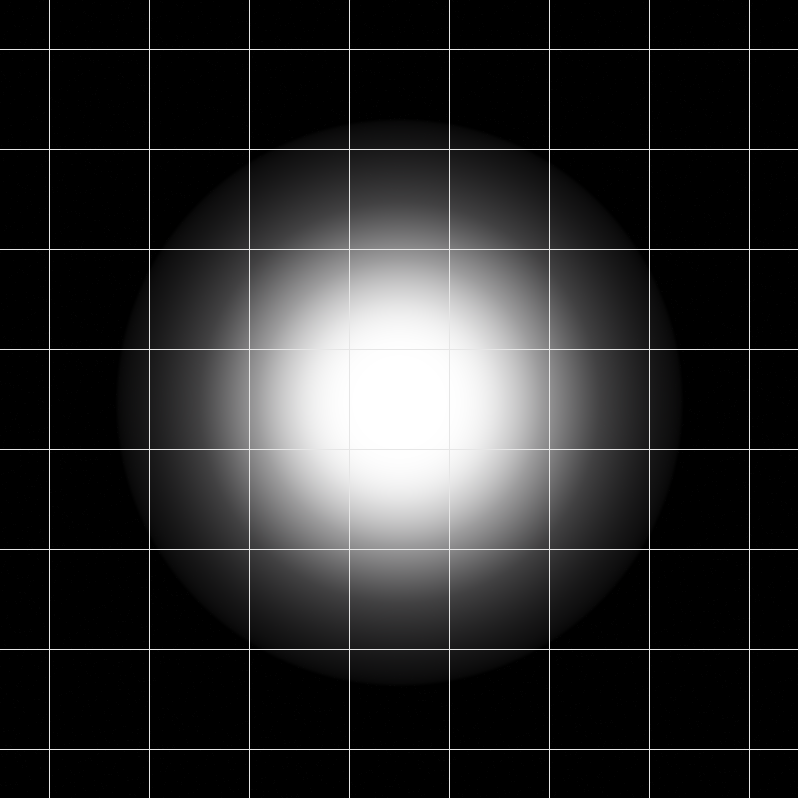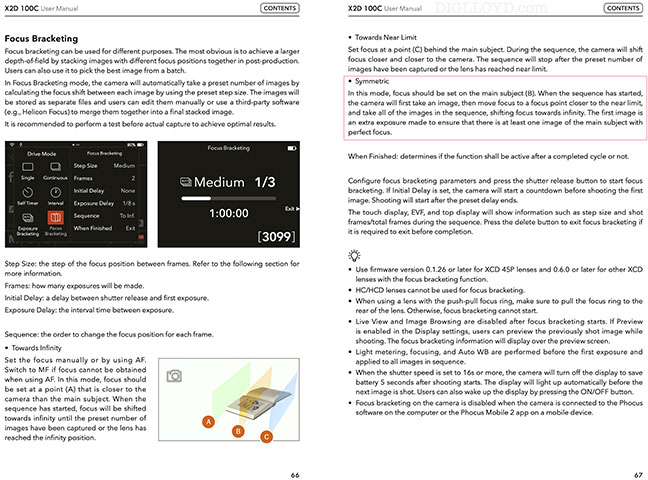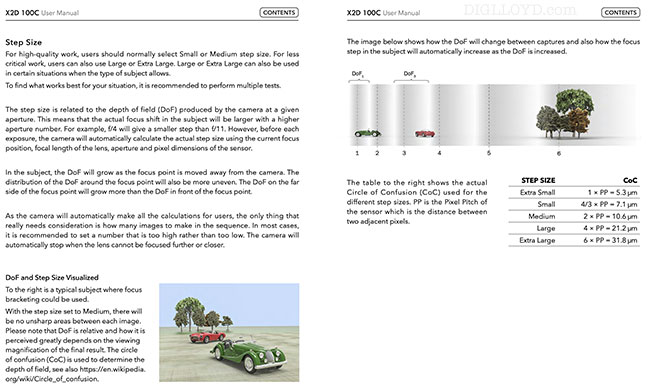Hasselblad X2D 100C: Step Size for its Focus Bracketing Feature

vs sensor photosite size
re: Hasselblad X2D 100C: Best Focus Bracketing Support Yet of Any Brand?
The Hasselblad X2D user manual apparently contains an error regarding the step size: the figures are the same as for the 50-megapixel Hasselblad X1D II 50C. Of course, it could be that the the manual is correct and the firmware is buggy. Presumably not.
Hasselblad X2D 100C: Step Size
Pixel pitch (PP) = linear dimension of a sensor photosite eg 3.76 microns on the Hasselblad X2D, Fujifilm GFX100*, Sony A7R IV/V, and 5.3 microns on Hasselblad X1D.
Most cameras offer 10 step sizes. Hasselblad went with 5 steps. This is probably OK.
Discussion in the X2D manual is really good with respect to its pictures/diagrams, in terms of helping photographers understand the general idea. But in terms of actionable choices vs aperture choice, it is not helpful.
Discussion ignores a key issue: Airy Disc size (see Resolving to the Sensor Resolution), and talks only to Circle of Confusion (CoC). The Airy Disc is the minimum resolvable spot size whereas CoC as used in the manual apparently defines a cutoff for how much out of focus blur is acceptable, eg depth of field.
Behavior of a Bayer matrix sensor is sloppy compared to both both CoC and Airy Disc; the sensor cannot actually resolve a single pixel (pixel shift mode might do it). And real lenses often don’t behave nicely for the maths, what with focus shift and field curvature and aberrations that smear things.
Both Airy Disc and CoC must be considered for optimal images. Were that not true, f/22 would be the aperture to use for every landscape photo. But at f/22, you get a massive loss of contrast and resolution: a very deep zone of mashed detail (very large Airy Disc eg no fine detail) and grayed-out contrast... garbage.
There is a sweet spot for depth of field vs Airy Disc size vs sensor pixel pitch which boils down to f/5 to f/9 range for the X2D and similar and 35mm cameras. And only that range.
Below, the table is defining the cutoff criteria is for the Circle of Confusion used to determine the scaling factor based on aperture for the step size. But it is ignoring Airy Disc.
For any Step Size, use of f/11 vs f/5.6 means steps 2X as deep with 1/2 the frames. Given that, these numbers have no practical utility for the photographer. They are useful only in the context of the Airy Disc, which Hasselblad does not discuss.
| Step Size | X1D II 50C | X2D 100C |
|---|---|---|
| Extra Small | 1 * PP = 5.3 | 1 * PP = 3.76 |
| Small | 4/3 * PP= 7.1 | 4/3 * PP = 5.0 |
| Medium | 2 * PP = 10.6 | 2 * PP = 7.5 |
| Large | 4 * PP = 21.2 | 4 X PP = 15.0 |
| Extra Large | 6 * PP = 31.8 | 6 X PP = 22.6 |
| The step size is related to the depth of field (DoF) produced by the camera at a given aperture. this means that the actual focus shift in the subject will be larger with a higher aperture number. E.g. f/4 will give a smaller step than f/11. However, before each exposure, the camera will automatically calculate the actual step size using the current focus position, focal length of the lens, aperture and pixel dimensions of the sensor. | ||
Recommendations for Step Size for Hasseblad X2D
Based on consideration of both CoC and Airy Disc size for the aperture along with considering how the X2D Bayer matrix sensor behaves, along with long experience focus stacking.
Choose shooting aperture, then choose the Step Size that keeps the CoC + Airy Disc consistent with each other.
For example, it rarely if ever makes sense to use Extra Small at f/11 because the Airy Disc is huge at ~14 microns, so an cutoff off 3.76 makes little sense—the Airy Disc is 14X larger in area than the cutoff size.
However, it’s not always just numbers. Additional overlap in real-world images can be important when focus stacking. For example, two things at very different distances can cause blur haloes which make it nearly impossible to achieve a quality result. Tighter spacing can help in such cases. Another case is a scene with motion, where subject matter in one frame is more acceptable than another, and both are reasonably sharp.
Symmetric mode (single-shot intent for best actual focus): go with Extra Small to achieve fine-tuned focus positions, along with 4 to 6 frames. One of those should be just right for the 3D subject you are capturing.
All of this assumes perfection in execution by the camera. Accordingly, these trecommendations are tentative pending my field use of the X2D. The best way to be sure is to shoot the same stack once at with Small and another time with Medium, then stack them and check all resultings aspects.
| f/# | Airy Disc Size | Recommended Step Size | Comment |
|---|---|---|---|
| 2 | 2.54 | Extra Small, CoC = 3.76 | Not advised for focus stacking |
| 2.8 | 3.55 | Extra Small, CoC = 3.76 | Not advised for focus stacking |
| 4 | 5.08 | Small, CoC = 5.0 | Not advised for focus stacking |
| 5.6 | 7.11 | Small, CoC = 5.0 Medium, CoC = 7.5 |
Peak brilliance but more frames at f/5.6. |
| 8 | 10.15 | Medium, CoC = 7.5 | Brilliance is dulling, but fewer frames. |
| 11 | 13.96 | Large, CoC = 15.0 | F/11 impacts resolution and contrast noticeably. |
| 16 | 20.3 | Large, CoC = 15.0 | Not advised for any situation. |
Airy Disc size by aperture
Helps explain the above recommendations.
The Airy Disc size rapidly overwhelms the pixel pitch. For example, at f/8, the Airy Disc size is around 10 microns, so a Step Size of Medium makes sense. But at f/5.6, you’d perhaps want to use Small, and at f/4, Extra Small. This idea is NOT explained well.
Airy Disc size rapidly overwhelms the pixel pitch of the X2D . Thus the choice of Step Size really comes down not to depth of field as stated, but resolvable detail. And that depends only on aperture. Thus it becomes an exercise of choosing a step size that is symbiotic with the shooting aperture.
Airy Disk diameter microns ~= 2.44 × wavelength × FNumber / 1000
Even though the Airy Disc size of 7.11 microns at f/5.6 is already 4X larger in area than the 3.76 micron photosites, there is very little detectable diffraction loss. Hence I take 2 * pixel pitch as the cutoff for acceptable Airy Disc size.
| f/# | Airy Disk Diameter at 520nm (microns) [Edmund Optics] |
|---|---|
| 2 | 2.54 |
| 2.8 | 3.55 |
| 4 | 5.08 |
| 5.6 | 7.11 |
| 8 | 10.15 |
| 11 | 13.96 |
| 16 | 20.30 |

Hasselblad also does an excellent job of explaining step size.
























